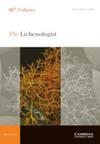地衣真菌黄原菌的局部泛混合菌与其树状光生物的实质遗传结构形成对比
IF 1.4
4区 生物学
Q4 MYCOLOGY
引用次数: 1
摘要
微卫星标记可以提供有价值的基因流动和种群历史信息。在德国巴伐利亚州慕尼黑市区,对亲硝性地衣真菌parietina黄病菌(Xanthoria parietina)进行了微卫星检测和遗传多样性研究。我们将其本地遗传模式与其光生物伙伴脱色Trebouxia decolorans的遗传模式进行了比较,后者应用了现有的微卫星。为了进行比较,在采样中加入了一个空气清洁的参考站点。我们发现在真菌中存在3个遗传簇,这些遗传簇在不同的采集地点混杂出现。真菌群体和个体之间存在高度的混杂,分子变异分析表明真菌群落结构缺乏。相比之下,Trebouxia光生物表现出结构化的群体,分为2到5个遗传簇,个体的混合性比真菌生物少。这表明这两种地衣伴侣在景观中移动的能力不同。我们报道的微卫星标记是多态的,适合于群体遗传研究。本文章由计算机程序翻译,如有差异,请以英文原文为准。
Local-scale panmixia in the lichenized fungus Xanthoria parietina contrasts with substantial genetic structure in its Trebouxia photobionts
Abstract Microsatellite markers can provide valuable information about gene flow and population history. We developed and tested new microsatellites for the nitrophilic lichenized fungus Xanthoria parietina and studied its genetic diversity and structure within the urban area of Munich, Bavaria. We compared its local genetic pattern with that of its photobiont partner Trebouxia decolorans, for which existing microsatellites were applied. For comparison, a reference site with clean air was included in the sampling. We found support for three genetic clusters in the fungus X. parietina, which occurred intermingled in collecting sites. There was a high degree of admixture within fungal populations and individuals, and analysis of molecular variance revealed a lack of population structure in the mycobiont. The Trebouxia photobiont, in contrast, exhibited structured populations which grouped into two to five genetic clusters, and individuals showed less admixture than in the mycobiont. This indicates that the two lichen partners differ in their ability to move around in the landscape. The microsatellite markers we report are polymorphic and are suitable for population genetic studies.
求助全文
通过发布文献求助,成功后即可免费获取论文全文。
去求助
来源期刊

Lichenologist
生物-真菌学
CiteScore
2.90
自引率
14.30%
发文量
23
审稿时长
6.0 months
期刊介绍:
The Lichenologist is the premier scientific journal devoted exclusively to the study of lichens worldwide. As the leading forum for the dissemination of new concepts and topical reviews, The Lichenologist reaches more scientists concerned with the study of lichens and lichen symbionts than any other single journal. All aspects of lichenology are considered including systematics and phylogenetics; molecular biology; ultrastructure, anatomy and morphology; secondary chemistry, effects of pollutants and use as bioindicators; biogeography. In addition to standard length research papers, the journal also publishes Short Communications and Book Reviews. A monthly issue may occasionally be devoted to papers deriving from a symposium.
 求助内容:
求助内容: 应助结果提醒方式:
应助结果提醒方式:


